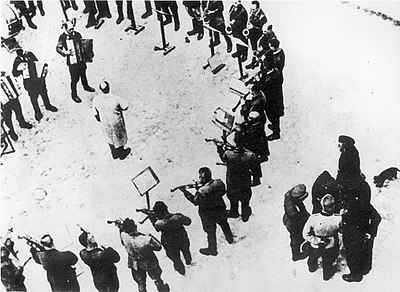Tango of Death
This article needs additional citations for verification. (September 2020) |
Tango of death | |
|---|---|
 A photo of the orchestra, which was used to illustrate Nazi crimes at the Nuremberg trials | |
| Background information | |
| Years active | 1941 — 1944 |
| Past members | Jacob Mund, Leon Strix, Jozef German, and others |
Tango of Death was a Jewish orchestra in the Janowska concentration camp, located on what is now the outskirts of Lviv, Ukraine.
History
[edit]In Lviv, which was seized at the end of June 1941, shortly after the Lviv pogrom carried out at the beginning of July, the "Jewish Worker Camp", later known as the Janowska concentration camp, began to form under the leadership of the German administration by the Ukrainian auxiliary police, formed from the "marching groups" of the OUN (Organization of Ukrainian Nationalists).
The initiator of the compulsory organization of musician-prisoners in the orchestra was the deputy commandant of the Janowska camp, SS-Untersturmführer Richard Rokita who before the war had "played the violin in a jazz band in Katowice."[1] Rokita was one of many sadistic villains at the camp; "Choice sadists and various scum of the Nazi death machine were in the Janowska concentration camp. Many of these people suffered from pathological perversions...The most diverse ways of killing people were used in this camp. Each Nazi tried to outdo his colleagues by discovering his own special killing method."[1]
The 40-person[1] orchestra consisted of the best Lviv musicians, Jewish prisoners of the camp, some of whom were famous within Europe or even world-famous. The violinist, composer, conductor Jacob Mund, who before the war held the position of musical director of city theaters, was appointed the head of the orchestra.[2] Among the orchestra musicians Josef German, violinist Leonid Stricks, and cellist Leon Eber. During "selections and actions," the orchestra performed a tango "Todestango" [Tango of Death]...composed by Yakub Munt (sp?), former director of the Lvov opera. The music was based on an earlier work by Eduardo Bianco."[3]
During torture the orchestra performed a foxtrot,[citation needed] and often played for several hours in a row under the window of the head of the concentration camp.
Shortly before the liberation of Lviv, all orchestra musicians were shot.[3] According to Ukrainian survivor Bohdan Kokh: "The most terrible day was the last one, when 25,000 Jews were shot...This operation ended with the last orchestra coming to the pit; they were undressed, they laid down their instruments; they went into the pit, but before that they played the 'Tango of Death' for themselves."[1]
Subsequently, a sonderkommando was formed, which was engaged in concealing the crimes of the nazis.
References
[edit]- ^ a b c d Pahiria, Oleksandr (2018-12-21). "Original text in Ukrainian language". In Bejger, Peter (ed.). The Janowska concentration camp: What we know and don't know. Translated from the Ukrainian by Marta D. Olynyk. UJE - Ukrainian Jewish Encounter. Retrieved 2023-01-10.
- ^ "Львов и Вторая мировая война. Часть 1".
- ^ a b "Members of the orchestra at the Janowska concentration camp perform while standing in a circle around the conductor, Yacub Mund, in the Appelplatz [roll call area]. - Collections Search - United States Holocaust Memorial Museum". collections.ushmm.org. Retrieved 2023-01-10.
Further reading
[edit]- Haan, Willem de (2023). Tango of death : the creation of a Holocaust legend. Jews, Judaism, and the Arts, Volume 3. Leiden, Boston: Brill. ISBN 978-90-04-52507-8. OCLC 1341211283.
- Hnatiuk, Ola (2019). "Chapter 6. Ukrainian Hamlet". Courage and Fear. Ukrainian Studies. Translated by Ewa Siwak. Boston: Academic Studies Press. pp. 301–398. doi:10.1515/9781644692523. ISBN 978-1-64469-252-3.
- "Janowska Forced Labor Camp - Industry of Terror - Каталог про виставку "Табір примусових робіт "Янівська" – індустрія терору". Ukrainian Jewish Encounter. Retrieved 2023-01-10 – via Issuu.
